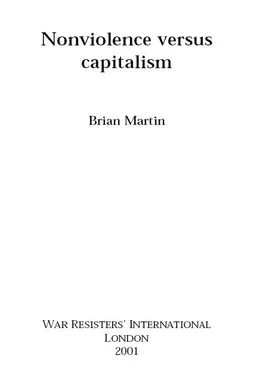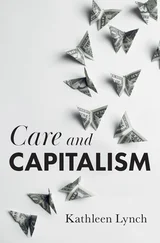The free software movement has been amazingly effective. Through voluntary contributions from programmers around the world, a vast library of free software has been produced. The most widely known is the operating system Linux, which has become a serious challenge to commercial software — primarily because it is so much more reliable — but there is much else available.
Considering its great achievements, free software has low visibility. A reader of the computer pages of newspapers — where the advertising comes from computer companies — would hardly know free software exists, much less that there is as much of it available as proprietary software.
Free software can be conceptualised as a campaign, though many of its participants are involved simply because they enjoy programming challenges.
1. Does the campaign help to
• undermine the violent underpinnings of capitalism, or
• undermine the legitimacy of capitalism, or
• build a nonviolent alternative to capitalism?
Free software is a potent challenge to the legitimacy of capitalism because it shows that voluntary, cooperative work can produce better products than some of the wealthiest corporations in the world. Free software is also part of a nonviolent alternative to capitalism, especially by challenging the expansion of the intellectual property system to cover software.
2. Is the campaign participatory?
Participation in development of free software is on the basis of competent contributions: programmers can be involved if they have something useful to contribute. Others can be involved by using and promoting free software.
3. Are the campaign’s goals built in to its methods?
The methods are much the same as the goals: development and use of free software. The main contradictory element is the use of copyright law to create “copyleft” in order to protect free software from commercial interlopers.
4. Is the campaign resistant to cooption?
The concept of free software is often confused with “shareware” which, though it sounds like a communal product, is actually commercial software that is available on a trial basis. Computers often are sold with software provided “free” (allegedly at no extra cost), but usually this is commercial software. In these ways the concept of free software is confused and appropriated by commercial software options.
Computer companies can adopt some free software as part of their own software packages, thus embedding the “free” elements in a commercial environment and obscuring the possibility of a more complete package of free software.
Much free software is written by programmers in their spare time who in their “day job” produce commercial software in a far more alienated environment. If computer firms could make programming more participatory and stimulating, programmers might not be so attracted to the opportunity to be involved with free software. However, since there are thousands of programmers contributing to free software worldwide, this form of cooption would need to be widespread to be effective in slowing the free software movement.
* * *
In summary, the free software movement is quite a challenge to capitalism, especially to the expansion of the property system to software. It combines means and ends effectively. As a practical alternative, it is participatory for programmers and software users while ensuring the highest quality products.
Capitalism has operated in a national mode for a long time, with rival governments defending the interests of national capital. Internationalism — for example, the fostering of free trade — is usually only in the interest of the most powerful capitalist countries. That continues to be the case today, with corporate globalisation being promoted most vigorously by the governments of the US and other wealthy countries.
The socialist movement, in contrast, was internationalist from its start in the 1800s. The idea was that workers had common interests and would unite against their common oppressors, the capitalists. In practice, nationalism was often a stronger force, especially in the case of war. Prior to World War I, working class organisations were pledged to oppose war between states, but after the outbreak of war, internationalist ideals were forgotten as workers volunteered to fight against their counterparts in enemy countries.
As corporate globalisation proceeds, the need for globalisation of opposition increases, but this inevitably involves action in local situations. Campaigns against the MAI and against corporate control over life forms are two examples of campaigns that can be described as both global and local. Trade agreements and patents on life forms have global implications and the proponents of these initiatives plan on a global scale. Therefore opponents need to operate globally as well. This includes targeting international forums, coordinating actions in different parts of the world and trying to meld together participants from a range of countries and constituencies. To achieve this, a local dimension is vital. The impacts of corporate globalisation are felt most acutely in local communities, and it is in such communities that global campaigns must be built. Without local participation and initiative, campaigners operating at the level of international meetings and media can easily lose touch with grassroots concerns and become more susceptible to cooption.
There is nothing all that new about global-local campaigning. Colonialism was a process of international exploitation, and independence movements were commonly aided by sympathisers and support groups within the colonial power. Many workers’ struggles have had international dimensions, and the struggle against nuclear power has involved national movements with international networking. But with corporate globalisation, global impacts are becoming more significant in many areas.
In between the global and the local are a host of intermediate scales, including national and regional and all sorts of networks. This means that there is increasing organisational complexity in campaigning. Making campaigns participatory is an extra challenge when groups from around the world and from different cultures are involved.
12. Economic alternatives as strategies
One fruitful way to develop strategies is to work out components of the goal and then turn them into methods. This approach has the great advantage that the goal is built into the method, so that there is less chance of the strategy serving the wrong ends.
Nonviolence itself exemplifies this approach of using the goal as a strategy. The goal is a society without organised violence, in which conflict is dealt with using nonviolent methods. To achieve this goal, a key method is nonviolent action. This gives experience in using nonviolent action, refines understanding of nonviolence as a goal, and helps overcome reliance on violent methods.
For a nonviolence strategy against capitalism, turning goals into methods means working out a nonviolent economic alternative to capitalism and then turning the alternative--or a component of it--into a method for change. This can be a highly effective approach.
One economic alternative is promoting cooperatives, which are collective enterprises in agriculture, manufacturing, retail, services or any of a number of areas. In cooperatives, workers and users are in control, without bosses. Decisions are made participatively, typically by consensus or voting. Cooperatives are enterprises run by workers’ control, a strategy that was analysed in chapter 7. As a strategy, cooperatives are more commonly built from scratch by a group of people committed to a collective, self-managing approach, whereas workers’ control can occur by workers taking over an existing enterprise.
Читать дальше

![Brian Jacques - Martin the Warrior [Redwall 6]](/books/128385/brian-jacques-martin-the-warrior-redwall-6-thumb.webp)










